APRILIA RALLY 50
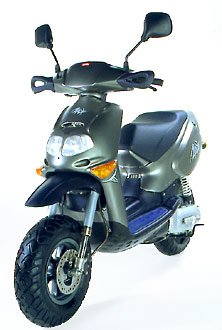
The 2004 Rally 50 was introduced to the USA market at a time when Aprilia was fairly new to the American scooter scene and frequently changing their USA lineup. For the 2004 model year Aprilia boosted their scooter lineup from four scooters to ten, perhaps in an attempt to figure out what would sell in the USA. Also going on at this time was the potential bankruptcy of Aprilia, which was averted when they were purchased by Piaggio in mid 2004. Within the context of this unstable lineup, the Rally 50 was introduced to the American audience for 2004. It was never offered to Canadians.
Following slow sales in 2004, manufacturing of the Rally 50 was ceased not only for the USA market, but also worldwide. The Rally 50 was originally introduced in some overseas markets in 1994, so the design was aging when it arrived in the USA. Accordingly, the Rally 50 is a rare but not valuable scooter in the USA. Had Aprilia opted to design a follow-up generation for this scooter and continued to offer it in North America, it likely would have sold well during the strong sales years of 2005 – 2007. In a way, the 2014 Aprilia SR Motard 50 resurrects the Rally 50’s off-road spirit.
 Engine
Engine
The Rally 50 was originally introduced overseas with an air-cooled motor, and this scooter was called the ‘Air Rally’ or the ‘Rally AC’. In 1996, Aprilia added a liquid cooled version (Rally LC), but it was the lower cost air cooled version that sold in higher numbers and was introduced to the USA market for 2004 as simply the Rally 50. This air cooled engine was a 2-stroke 49cc horizontal Minarelli.
This engine’s horizontal Minarelli design was shared with a large number of other contemporary scooters including Aprilia’s 2-stroke Scarabeo 50 and Yamaha’s 2002 – 2011 Zuma 50, but interchanging parts between different Minarelli engines can be a bit tricky as there have been so many different versions and tweaks. For example, the Zuma uses a low compression (7.0:1) cylinder/head design, while the Rally 50 uses a surprisingly high (13.0:1) compression ratio and thus requires premium fuel. Aprilia’s own 2-stroke generation of Scarabeo 50 (2000 – 2006) contains virtually the same Minarelli engine as the Rally 50, so this scooter is your best bet if you’re looking at sourcing new or used parts from another model.
In terms of performance, the Rally 50 really excels. To meet moped/scooter laws in many areas, the power of the Rally 50 was hampered via a restriction in the exhaust. As well, the top end gearing was restricted by a spacer in the variator. Removing these two minions results in more power and the top speed gearing to utilize it. Top speed for an unrestricted Rally 50 is around 50 mph. From there, you can install tons of aftermarket parts to raise power (and lower reliability) to whatever level you desire. Lots of parts are available from ProvoScooter and AF1 Racing. The latter site is a real gold mine of goodies.
The Rally 50 isn’t as good at conserving fuel as it is at making power, but it does okay. Unless you pour on the performance modifications, a Rally 50 will return 65-70 mpg, which is fairly average for a 2-stroke but lagging most slower but economical 4-stroke 50’s.
Styling
The fat tired Rally 50 is a clear entry in the sports/off-road scooter category that was basically invented by the late 80’s first generation Yamaha Zuma. The mid 90’s saw Aprilia introduce the Rally 50 into this category at about the same time Kymco debuted their competing Cobra Cross scooter. Those two scooters sold well in Europe.
The Rally 50 achieves its dirt hungry look by slapping a serious amount of rubber on small 10” rims (120/90-10 front, 130/90-10 rear). It’s this rubber combined with the raised front fender, generous amount of suspension and ample ground clearance that really gives the Rally 50 its dirt ready attitude. Contrasting this, the headlights have a fairly standard sports look to them, as does the rear half of the scooters body. The overall result looks like Aprilia took a sports scooter and jacked it up for the off-road.
During its brief tenure in the USA, the Rally 50 was sold in two colors – Chips Blue and Saddle Black. The Saddle Black version was a solid color, while the Chips Blue Rally 50 utilized an orange under-belly and orange graphics. All Rally 50’s were built in Italy.
 Brakes / Suspension / Handling
Brakes / Suspension / Handling
The use of an inverted front fork really set the Rally 50 apart from other scooters. An inverted fork is typically a higher end component that improves suspension performance by reducing the unsprung wheel weight. No other 50cc scooter ever offered to the North American market has used an inverted fork, likely because manufacturers typically use low cost suspension components and leave it to the customer to upgrade. In the case of the Rally 50, the inverted fork gives the scooter more of a dirt bike / motard look.
Stopping the Rally 50 is handled by an averaged size disc brake up front and a fairly standard drum brake in the rear. Overall performance is a step down from Aprilia’s top of the line SR50, but it’s still a nice step up from most 50’s on the market which use lethargic drum brakes at both ends.
Storage & Convenience
A big part of the appeal of a scooter is its convenience and practicality. The Rally 50 scores average marks in this area. Like virtually all scooters, there is decent storage under the seat which acts as a great spot for your safety cap while the scooter is parked and a haven for everything else when you’re rolling. The Rally uses a horizontal engine and fairly small wheels, which means there’s no significant intrusions into the underseat space. All told, the Rally 50 scores a bit better than average for underseat storage.
Unfortunately Aprilia didn’t give the Rally a glovebox or any other locking cubby-holes like they’ve done on some of their other small scooters. Accordingly, little odds and ends like a small bottle of 2-stroke oil, a spare plug and your paperwork will need to compete with your helmet and other goodies for the underseat space.
The gauges on the Rally 50 are super nice. They’re not at the SR50’s super computer level of awesome, but they are very tastefully done. The speedometer occupies the left of two large gauges, while an aircraft style fuel gauges occupies the right side. There’s no tachometer which would be helpful for tuning, but Aprilia did add a trip odometer which you don’t see on too many small scooters.
 Comparison
Comparison
Back in 2004 Aprilia priced the Rally 50 at $1799, which was pretty darn affordable. This compares well with Yamaha’s Zuma 50, which hovered a bit under two grand back then. Aprilia makes really nice high quality scooters, so if you’re looking for something less mainstream then the Zuma, the Rally 50 is a neat option. You’re definitely not going to wind up beside too many of these at red lights.
Kymco’s Cobra Cross is another close competitor. Kymco set the 2004 MSRP pretty high for that scooter ($2399) considering the Rally 50 is the nicer machine, but a Cobra might be worth a look if you come across a good deal on a used one. The other off-road styled 2-stroke 50 that was on sale during this period was Piaggio’s Typhoon 50. Like the Rally, the Typhoon is a really cool scooter with a sports scooter body sitting on jacked up fat wheels. The choice between these two scooters mostly comes down to styling preference and what sort of deal you can find.
A final option is Honda’s Ruckus, which marries off-road styling with a 4-stroke engine. The four cycle Ruckus easily beats any of these other scoots at the gas pumps but not off the line. The Ruckus also wins for emissions, noise and motor longevity, but the price for all that is much lower 4-stroke power. A Ruckus can wander to 37 – 42mph and additional gains are hard to come by, while an unrestricted 2-stroke can often achieve 50 mph with much higher speeds only a few hundred in parts away.
Pros:
- Aprilia quality
- Inverted front suspension
- Rare scooter in USA
Cons:
- 2-stroke mileage + Premium fuel required
- Very few used parts out there for fixing one up
Links:
MotorscooterGuide Forums – Visit the forums on this site to chat about this scoot.
ApriliaForums – Good info on the Rally 50 and a great way to get connected to the online community.
Rally 50 Service Manual – Nice PDF download for working on your Rally.
Aprilia Rally 50 Key Specs:
- Engine: 49.26cc, single cylinder, air-cooled, 2-stroke
- Compression: 13.0:1
- Bore x stroke: 40.0 x 39.2 mm
- Fuel system: Dell’Orto PHBN 12 Carburetor
- Ignition: CDI
- Starter: Electric & Kick
- Lubrication system: Oil injected
- Clutch: Automatic centrifugal dry clutch
- Weight: 192 lbs
- Seat height: 31.5”
- Overall length: 70.8”
- Overall height: 44.4”
- Overall width: 27.6”
- Wheelbase: 48.8”
- Front suspension: Hydraulic fork, 90 mm wheel travel
- Rear suspension: Hydraulic, single shock
- Tires: 120/90-10, 130/90-10 (front and rear)
- Rims: 5 spoke, Aluminum, 10”
- Front brake: Single 190mm disc
- Rear brakes:110mm Drum
- Fuel capacity: 1.6 gallon
- MSRP: $1799
- Colors: Chips Blue, Saddle Black

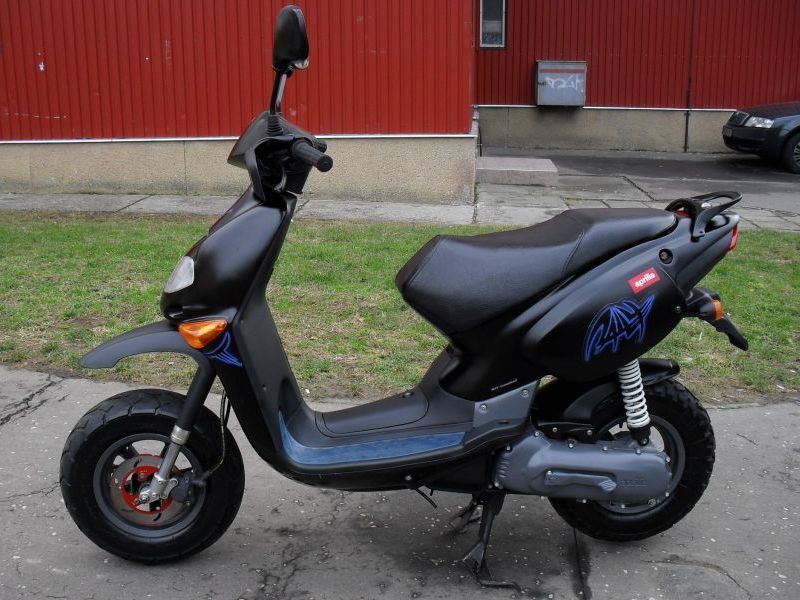
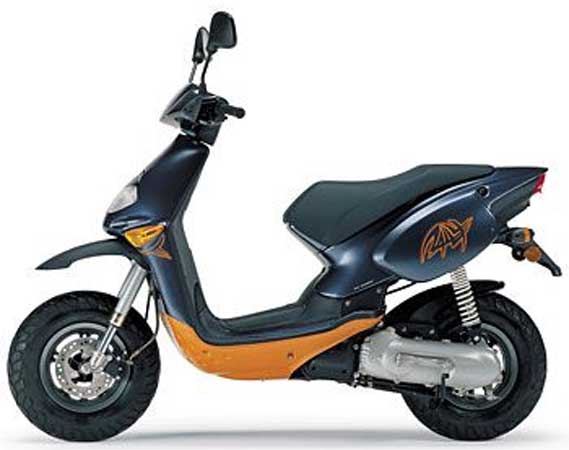 Engine
Engine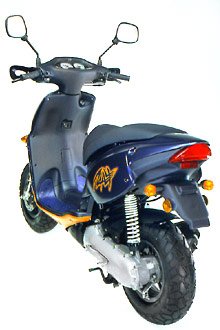 Brakes / Suspension / Handling
Brakes / Suspension / Handling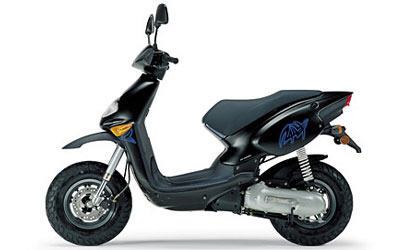 Comparison
Comparison